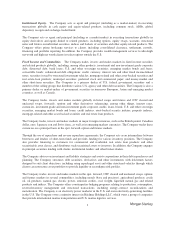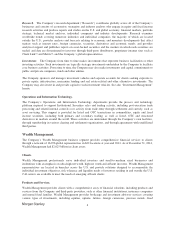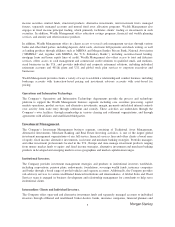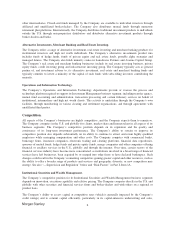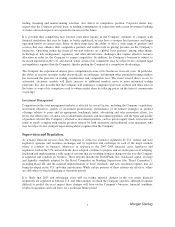Morgan Stanley 2014 Annual Report Download - page 17
Download and view the complete annual report
Please find page 17 of the 2014 Morgan Stanley annual report below. You can navigate through the pages in the report by either clicking on the pages listed below, or by using the keyword search tool below to find specific information within the annual report.
regarding contingent capital, enhanced public disclosures, and limits on short-term debt, including off-balance
sheet exposures.
In February 2014, the Federal Reserve issued final rules to implement certain requirements of the Dodd-Frank
Act’s enhanced prudential standards. Effective on January 1, 2015, the final rules require bank holding
companies with $50 billion or more in total consolidated assets, such as the Company, to conduct internal
liquidity stress tests, maintain unencumbered highly liquid assets to meet projected net cash outflows for 30 days
over the range of liquidity stress scenarios used in internal stress tests, and comply with various liquidity risk
management requirements. In addition, the final rules require institutions to comply with a range of risk
management and corporate governance requirements, such as establishment of a risk committee of the board of
directors and appointment of a chief risk officer, both of which the Company already has. Under the final rules,
upon a grave threat determination by the FSOC, the Federal Reserve must require the affected bank holding
company to maintain a debt-to-equity ratio of no more than 15-to-1 if the FSOC considers it necessary to
mitigate the risk.
In addition, the Federal Reserve has proposed rules that would limit the aggregate exposure of each bank holding
company with $500 billion or more in total consolidated assets, such as the Company, and each company
designated by the FSOC, to other such institution to 10% of the aggregate capital and surplus of each institution,
and limit the aggregate exposure of such institutions to any other unaffiliated counterparty to 25% of the
institution’s aggregate capital and surplus. The proposed rules would also create a new early remediation
framework to address financial distress or material management weaknesses determined with reference to four
levels of early remediation, including heightened supervisory review, initial remediation, recovery, and
resolution assessment, with specific limitations and requirements tied to each level. The Federal Reserve has
stated that it will issue, at a later date, final rules establishing single counterparty credit limits and an early
remediation framework.
See also “—Capital and Liquidity Standards” herein and “—Resolution and Recovery Planning” below.
Resolution and Recovery Planning. Pursuant to the Dodd-Frank Act, the Company is required to submit to the
Federal Reserve and the FDIC an annual resolution plan that describes its strategy for a rapid and orderly
resolution under the U.S. Bankruptcy Code in the event of material financial distress or failure of the Company.
On August 5, 2014, the Federal Reserve and the FDIC notified the Company and 10 other large banking
organizations that certain shortcomings in their 2013 resolution plans must be addressed in the 2015 resolution
plans, which must be submitted on or before July 1, 2015. If the Federal Reserve and the FDIC were to determine
that the Company’s resolution plan is not credible or would not facilitate an orderly resolution and the Company
does not cure the plan’s deficiencies, the Company or any of its subsidiaries may be subjected to more stringent
capital, leverage, or liquidity requirements or restrictions on its growth, activities, or operations, or the Company
may be required to divest assets or operations.
In addition, MSBNA must submit to the FDIC an annual resolution plan that describes MSBNA’s strategy for a
rapid and orderly resolution in the event of a material financial distress or failure of MSBNA. On December 17,
2014, the FDIC issued guidance regarding the resolution plans for insured depository institutions such as
MSBNA, including requirements with respect to failure scenarios and the development and analysis of a range of
realistic resolution strategies.
Further, the Company is required to submit an annual recovery plan to the Federal Reserve that outlines the steps
that management could take over time to reduce risk, increase liquidity, and conserve capital in times of
prolonged stress.
Certain of the Company’s foreign subsidiaries are also subject to resolution and recovery planning requirements
in the jurisdictions in which they operate.
13


